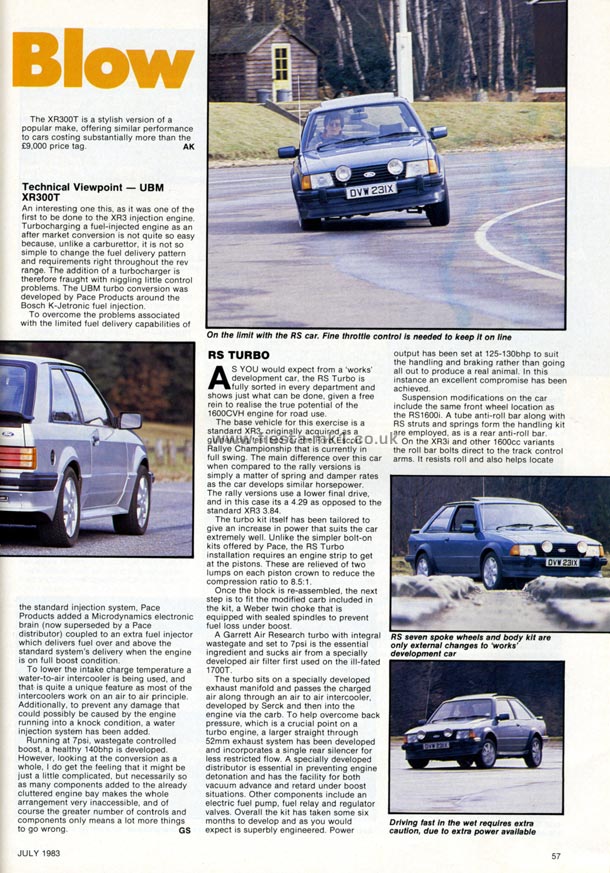Copy of Article Text Below
.....The XR300T is a stylish version of a popular make, offering similar performance to cars costing substantially more than the £9,000 price tag. AK
Technical Viewpoint - UBM XR300T
An interesting one this, as it was one of the first to be done to the XR3 injection engine. Turbocharging a fuel-injected engine as an after market conversion is not quite so easy because, unlike a carburettor, it is not so simple to change the fuel delivery pattern and requirements right throughout the rev range. The addition of a turbocharger is therefore fraught with niggling little control problems. The UBM turbo conversion was developed by Pace Products around the Bosch K-Jetronic fuel injection.
To overcome the problems associated with the limited fuel delivery capabilities of the standard injection system, Pace Products added a Microdynamics electronic brain (now superseded by a Pace distributor) coupled to an extra fuel injector which delivers fuel over and above the standard system's delivery when the engine is on full boost condition.
To lower the intake charge temperature a water-to-air intercooler is being used, and that is quite a unique feature as most of the intercoolers work on an air to air principle. Additionally, to prevent any damage that could possibly be caused by the engine running into a knock condition, a water injection system has been added.
Running at 7psi, wastegate controlled boost, a healthy 140bhp is developed. However, looking at the conversion as a whole, I do get the feeling that it might be just a little complicated, but necessarily so as many components added to the already cluttered engine bay makes the whole arrangement very inaccessible, and of course the greater number of controls and components only means a lot more things to go wrong. GS
RS TURBO
As you would expect from a 'works' development car, the RS Turbo is fully sorted in every department and shows just what can be done, given a free rein to realise the true potential of the 1600CVH engine for road use.
The base vehicle for this exercise is a standard XR3, originally acquired as a guinea pig test bed for the Ford Escort Rallye Championship that is currently in full swing. The main difference over this car when compared to the rally versions is simply a matter of spring and damper rates as the car develops similar horsepower. The rally versions use a lower final drive, and in this case its a 4.29 as opposed to the standard XR3 3.84.
The turbo kit itself has been tailored to give an increase in power that suits the car extremely well. Unlike the simpler bolt-on kits offered by Pace, the RS Turbo installation requires an engine strip to get at the pistons. These are relieved of two lumps on each piston crown to reduce the compression ratio to 8.5:1.
Once the block is re-assembled, the next step is to fit the modified carb included in the kit, a Weber twin choke that is equipped with sealed spindles to prevent fuel loss under boost.
A Garrett Air Research turbo with integral wastegate and set to 7psi is the essential ingredient and sucks air from a specially developed air filter first used on the ill-fated 1700T.
The turbo sits on a specially developed exhaust manifold and passes the charged air along through an air to air intercooler, developed by Serck and then into the engine via the carb. To help overcome back pressure, which is a crucial point on a turbo engine, a larger straight through 52mm exhaust system has been developed and incorporates a single rear silencer for less restricted flow. A specially developed distributor is essential in preventing engine detonation and has the facility for both vacuum advance and retard under boost situations. Other components include an electric fuel pump, fuel relay and regulator valves. Overall the kit has taken some six months to develop and as you would expect is superbly engineered. Power output has been set at 125-130bhp to suit the handling and braking rather than going all out to produce a real animal. In this instance an excellent compromise has been achieved.
Suspension modifications on the car include the same front wheel location as the RS1600i. A tube anti-roll bar along with RS struts and springs form the handling kit are employed, as is a rear anti-roll bar.
On the XR3i and other 1600cc variants the roll bar bolts direct to the track control arms. It resists roll and also helps locate.....
Captions -
Top-Right - On the limit with the RS car. Fine throttle control is needed to keep it on line
Middle-Right - RS seven spoke wheels and body kit are only external changes to 'works' development car
Bottom-Right - Driving fast In the wet requires extra caution, due to extra power available
|







